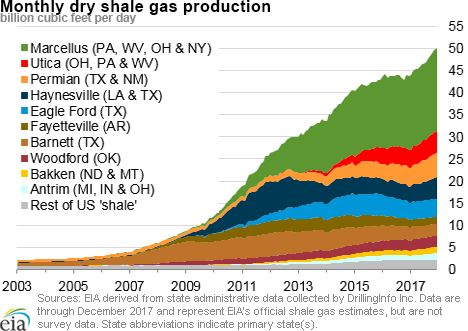In the News:
U.S. natural gas prices to remain low despite increasing exports, according to AEO2018
EIA’s Annual Energy Outlook 2018 (AEO2018), released on February 6, projects U.S. dry natural gas production to generally increase through 2050 in all cases. In the Reference case, production over the projection period (2018–2050) is expected to average 2.8 trillion cubic feet (Tcf) per year higher than levels projected in a similar case in last year’s AEO (AEO2017). An increase in lower-cost resources in the Appalachian and Permian basins in the AEO2018 results in higher production levels at lower prices. In the AEO2018 Reference case, the Henry Hub spot price is projected to average 68¢ (in 2017 dollars) per million British thermal units (MMBtu) less than in a similar AEO2017 case. In addition, in all AEO2018 cases except the Low Oil and Gas Resource and Technology case, Henry Hub spot prices are projected to remain lower than $6.00/MMBtu (in 2017 dollars) through 2050.
As a result of increased production of low-cost natural gas in the AEO2018 Reference case, in 2050, net exports of natural gas are projected to be 2.6 Tcf higher than in the comparable AEO2017 case. Additionally, all cases in the AEO2018 project the United States to remain a net natural gas exporter through 2050.
The AEO2018 Reference case projects increases in pipeline exports to Mexico through nearly 2030. Imports of U.S. natural gas to Mexico have been increasing as a result of increased use of natural gas-fired power plants. However, pipeline exports to Mexico are expected to gradually decrease after 2028 as Mexican domestic production reverses its current decline and begins to increase. Although the United States currently imports 2.0 Tcf per year of natural gas by pipeline from Canada on a net basis, increasing low-cost U.S. natural gas production is projected to lead to the United States becoming a net exporter to Canada in 2042.
Although liquefied natural gas (LNG) exports from the United States increase through 2029 as more export terminals come online following the completion of the first four trains at the Sabine Pass LNG export terminal (with the latest in August 2017), U.S. LNG exports become less economic later in the projection period in most cases, which limits growth.
The AEO2018 presents long-term projections of energy supply, demand, and prices through 2050, based on results from EIA’s National Energy Modeling System. It includes a Reference case (which assumes laws and regulations are in force in their current form throughout the projection period) as well as alternate scenarios that incorporate different key assumptions about macroeconomic factors, technology and resource availability, and oil markets.
Overview:
(For the Week Ending Wednesday, February 7, 2018)
- Natural gas spot prices fell at most locations this report week (Wednesday, January 31 to Wednesday, February 7). The Henry Hub spot price fell from $3.21/MMBtu last Wednesday to $2.73/MMBtu yesterday.
- At the New York Mercantile Exchange (Nymex), the March 2018 contract price fell 29¢ from $2.995/MMBtu last Wednesday to $2.702/MMBtu yesterday.
- Net withdrawals from working gas totaled 119 billion cubic feet (Bcf) for the week ending February 2. Working natural gas stocks are 2,078 Bcf, which is 19% lower than the year-ago level and 16% lower than the five-year (2013–17) average for this week.
- The natural gas plant liquids composite price at Mont Belvieu, Texas, fell by 41¢, averaging $7.32/MMBtu for the week ending February 7. The price of natural gasoline, ethane, propane, butane, and isobutane all fell, by 3%, 14%, 1%, 4%, and 10%, respectively.
- According to Baker Hughes, for the week ending Tuesday, January 30, the natural gas rig count decreased by 7 to 181. The number of oil-directed rigs rose by 6 to 765. The total rig count decreased by 1, and it now stands at 946.
Prices/Supply/Demand:
Henry Hub price decreases with forecasts of warmer weather. This report week (Wednesday, January 31 to Wednesday, February 7), the Henry Hub spot price fell 48¢ from $3.21/MMBtu last Wednesday to $2.73/MMBtu yesterday, and the average price for the report week decreased 48¢, from $3.51/MMBtu over the last report week to $2.89/MMBtu over this report week. While national weekly average temperatures decreased modestly from last report week, national temperatures this report week have remained slightly higher than the 1981–2010 averages for this time of year, according to data from National Oceanic and Atmospheric Administration (NOAA), and are forecast to increase into next week.
Key Midwest trading hub price decreases. At the Chicago Citygate, prices decreased 44¢ from $3.11/MMBtu last Wednesday to $2.67/MMBtu yesterday. The weekly average price decreased 41¢, from $3.21/MMBtu over the last report week to $2.80/MMBtu over this report week.
California prices decrease. Prices at PG&E Citygate in Northern California fell 20¢, down from $2.74/MMBtu last Wednesday to $2.54/MMBtu yesterday. The weekly average price decreased 39¢, from $2.94/MMBtu over the last report week to $2.55/MMBtu over this report week.
The price at SoCal Citygate decreased 18¢ from $2.76/MMBtu last Wednesday to $2.58/MMBtu yesterday. The weekly average price decreased 69¢, from $3.11/MMBtu over the last report week to $2.42/MMBtu over this report week.
Natural gas consumption in California decreased from last report week to this report week as average temperatures increased.
Northeast price movements are mixed. At the Algonquin Citygate, which serves Boston-area consumers, prices went up $1.80 from $6.30/MMBtu last Wednesday to $8.10/MMBtu yesterday. The weekly average price decreased 68¢, from $8.74/MMBtu over the last report week to $8.06/MMBtu over this report week. Price movements through the week were generally correlated with daily temperature changes. Prices in New England tend to be higher than the national benchmark Henry Hub price in the winter, when demand is relatively high and regional pipeline system capacity constraints occur.
At the Transcontinental Pipeline Zone 6 trading point for New York, prices increased 28¢ from $4.53/MMBtu last Wednesday to $4.81/MMBtu yesterday. The weekly average prices were flat from last report week to this report week.
Appalachian prices decrease. Tennessee Zone 4 Marcellus spot prices decreased 41¢ from $2.81/MMBtu last Wednesday to $2.40/MMBtu yesterday. The weekly average price decreased 17¢, from $2.64/MMBtu over the last report week to $2.47/MMBtu over this report week.
Prices at Dominion South in northwest Pennsylvania fell 48¢ from $2.95/MMBtu last Wednesday to $2.47/MMBtu yesterday. The weekly average price decreased 23¢, from $2.86/MMBtu over the last report week to $2.63/MMBtu over this report week.
Despite these price decreases, the discount to the Henry Hub benchmark price at Tennessee Zone 4 Marcellus and Dominion South narrowed week over week, by 45¢ and 40¢, respectively.
Supply is flat. According to data from PointLogic Energy, the average total supply of natural gas remained the same as in the previous report week, averaging 84.1 billion cubic feet per day (Bcf/d). Dry natural gas production remained constant week over week at 78 Bcf/d. Net imports from Canada also remained the same as last week, averaging 5.8 Bcf/d.
Demand is up. Total U.S. consumption of natural gas rose by 13% compared with the previous report week, according to data from PointLogic Energy. Natural gas consumed for power generation climbed by 9% week over week, and industrial sector consumption increased by 5%. In the residential and commercial sectors, consumption increased by 20%. Natural gas exports to Mexico were the same as last week, averaging 4.5 Bcf/d.
U.S. LNG exports increase week over week. Six LNG vessels (LNG-carrying capacity 22.6 Bcf combined) departed the Sabine Pass liquefaction facility from January 31 to February 7. One tanker (LNG-carrying capacity of 3.5 Bcf) was loading at the terminal on Wednesday.
Storage:
Working gas deficit to the five-year average declines 32 Bcf. Net withdrawals from storage totaled 119 Bcf for the week ending February 2, compared with the five-year (2013–17) average net withdrawal of 151 Bcf and last year's net withdrawal of 142 Bcf during the same report week. Working gas stocks totaled 2,078 Bcf, which is 393 Bcf less than the five-year average and 503 Bcf less than last year at this time. All regions in the Lower 48 states except for the Pacific region are lower than year-ago levels.
Working gas stocks post net injections on the week in the South Central salt region for the second week in a row. Net injections into working gas stocks in the South Central salt region totaled 15 Bcf. These net injections came a week after working gas stocks posted the largest January net injection for the region on record and the second-largest net injection over the December to February time period. The deficit to the five-year average for the region declined from 124 Bcf to 67 Bcf during this two-week period.
The average March 2018 futures contract price trades at a discount to the average weekly spot price. During the most recent storage week, the average natural gas spot price at the Henry Hub was $3.38/MMBtu, 14¢/MMBtu higher than the price of the front-month futures contract for delivery at the Henry Hub on the Nymex. This pricing pattern provided economic incentives to withdraw natural gas from storage to avoid exposure to the spot market. A year ago, the spot price was 5¢ lower than the front-month contract.
Reported withdrawals out of storage are higher than the median of analysts’ expectations. According to The Desk survey of natural gas analysts, estimates of the weekly net change in working natural gas storage ranged from 104 Bcf to 133 Bcf, with a median of 114 Bcf. Prices for the futures contract for March delivery at the Henry Hub rose about 1¢/MMBtu, averaging $2.75/MMBtu, following the release of the Weekly Natural Gas Storage Report, with 213 contracts traded at the release. Prices varied and declined in subsequent trading, falling to $2.72/MMBtu.
Temperatures are higher than normal during the storage week throughout most of the Lower 48 states. Temperatures in the Lower 48 states averaged 40 degrees Fahrenheit (°F), which was 6°F higher than the normal, 2°F higher than the same week last year, and the same average temperature as the prior storage week.
See also:
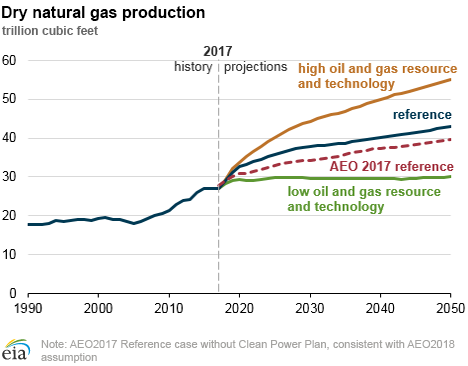 Source: U.S. Energy Information Administration, Annual Energy Outlook 2018
Source: U.S. Energy Information Administration, Annual Energy Outlook 2018
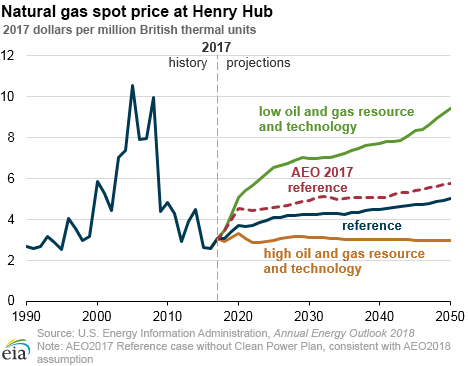
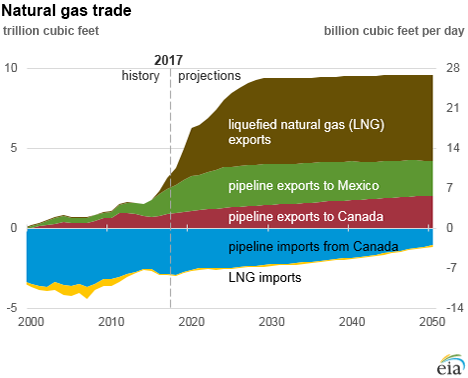 Source: U.S. Energy Information Administration, Annual Energy Outlook 2018
Source: U.S. Energy Information Administration, Annual Energy Outlook 2018
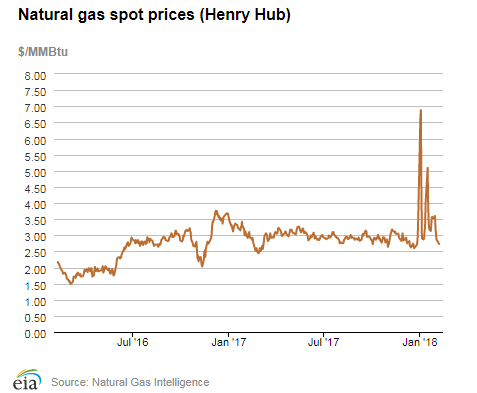
| Spot Prices ($/MMBtu) | Thu, 01-Feb |
Fri, 02-Feb |
Mon, 05-Feb |
Tue, 06-Feb |
Wed, 07-Feb |
|---|---|---|---|---|---|
| Henry Hub |
3.02 |
2.86 |
2.79 |
2.75 |
2.73 |
| New York |
7.87 |
4.67 |
3.48 |
3.00 |
4.81 |
| Chicago |
2.89 |
2.76 |
2.71 |
2.70 |
2.67 |
| Cal. Comp. Avg.* |
2.40 |
2.11 |
2.19 |
2.25 |
2.27 |
| Futures ($/MMBtu) | |||||
| March contract | 2.856 |
2.846 |
2.747 |
2.759 |
2.702 |
| April contract |
2.793 |
2.792 |
2.726 |
2.723 |
2.692 |
| *Avg. of NGI's reported prices for: Malin, PG&E Citygate, and Southern California Border Avg. | |||||
| Source: NGI's Daily Gas Price Index | |||||
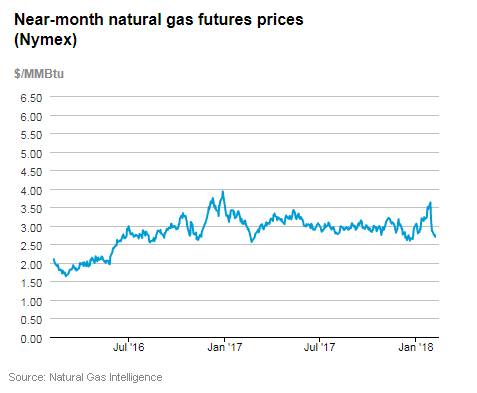
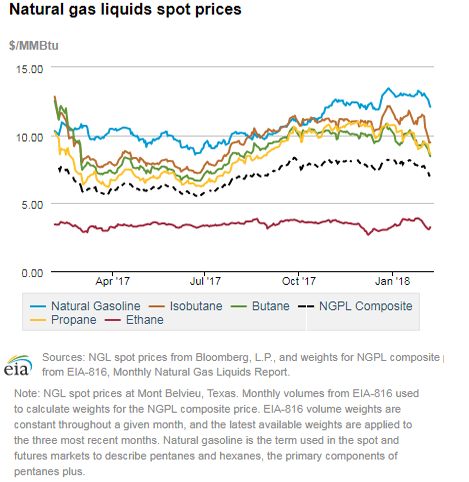
| U.S. natural gas supply - Gas Week: (2/1/18 - 2/7/18) | |||
|---|---|---|---|
Average daily values (Bcf/d): |
|||
this week |
last week |
last year |
|
| Marketed production | 87.5 |
87.2 |
79.2 |
| Dry production | 77.9 |
77.7 |
70.8 |
| Net Canada imports | 5.8 |
5.9 |
6.0 |
| LNG pipeline deliveries | 0.3 |
0.2 |
0.2 |
| Total supply | 84.1 |
83.8 |
77.0 |
|
Source: OPIS PointLogic Energy, an IHS Company | |||
| U.S. natural gas consumption - Gas Week: (2/1/18 - 2/7/18) | |||
|---|---|---|---|
Average daily values (Bcf/d): |
|||
this week |
last week |
last year |
|
| U.S. consumption | 92.8 |
82.0 |
81.8 |
| Power | 23.3 |
21.4 |
20.9 |
| Industrial | 23.8 |
22.7 |
22.5 |
| Residential/commercial | 45.7 |
38.0 |
38.5 |
| Mexico exports | 4.5 |
4.5 |
4.1 |
| Pipeline fuel use/losses | 7.3 |
6.4 |
6.4 |
| LNG pipeline receipts | 3.3 |
3.2 |
2.0 |
| Total demand | 107.9 |
96.1 |
94.3 |
|
Source: OPIS PointLogic Energy, an IHS Company | |||
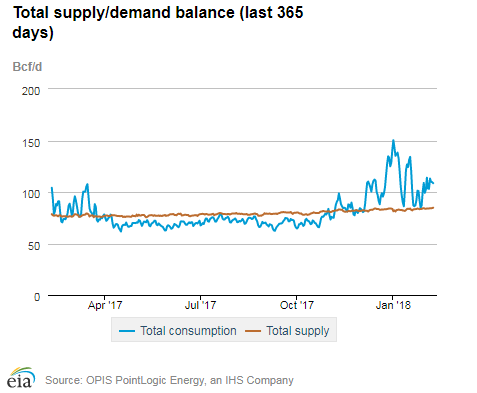
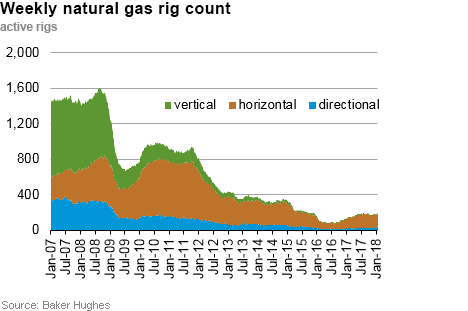
| Rigs | |||
|---|---|---|---|
Fri, February 02, 2018 |
Change from |
||
last week |
last year |
||
| Oil rigs | 765 |
0.8% |
31.2% |
| Natural gas rigs | 181 |
-3.7% |
24.8% |
| Note: Excludes any miscellaneous rigs | |||
| Rig numbers by type | |||
|---|---|---|---|
Fri, February 02, 2018 |
Change from |
||
last week |
last year |
||
| Vertical | 66 |
0.0% |
-1.5% |
| Horizontal | 808 |
0.0% |
35.6% |
| Directional | 72 |
-1.4% |
9.1% |
| Source: Baker Hughes Inc. | |||
| Working gas in underground storage | ||||
|---|---|---|---|---|
Stocks billion cubic feet (Bcf) |
||||
| Region | 2018-02-02 |
2018-01-26 |
change |
|
| East | 488 |
525 |
-37 |
|
| Midwest | 543 |
596 |
-53 |
|
| Mountain | 131 |
137 |
-6 |
|
| Pacific | 213 |
220 |
-7 |
|
| South Central | 703 |
719 |
-16 |
|
| Total | 2,078 |
2,197 |
-119 |
|
| Source: U.S. Energy Information Administration | ||||
| Working gas in underground storage | |||||
|---|---|---|---|---|---|
Historical comparisons |
|||||
Year ago (2/2/17) |
5-year average (2013-2017) |
||||
| Region | Stocks (Bcf) |
% change |
Stocks (Bcf) |
% change |
|
| East | 527 |
-7.4 |
547 |
-10.8 |
|
| Midwest | 691 |
-21.4 |
633 |
-14.2 |
|
| Mountain | 156 |
-16.0 |
148 |
-11.5 |
|
| Pacific | 210 |
1.4 |
242 |
-12.0 |
|
| South Central | 996 |
-29.4 |
902 |
-22.1 |
|
| Total | 2,581 |
-19.5 |
2,471 |
-15.9 |
|
| Source: U.S. Energy Information Administration | |||||
| Temperature – heating & cooling degree days (week ending Feb 01) | ||||||||
|---|---|---|---|---|---|---|---|---|
HDD deviation from: |
CDD deviation from: |
|||||||
| Region | HDD Current |
normal |
last year |
CDD Current |
normal |
last year |
||
| New England | 237 |
-36 |
14 |
0 |
0 |
0 |
||
| Middle Atlantic | 228 |
-34 |
14 |
0 |
0 |
0 |
||
| E N Central | 228 |
-64 |
-20 |
0 |
0 |
0 |
||
| W N Central | 263 |
-43 |
23 |
0 |
0 |
0 |
||
| South Atlantic | 152 |
-26 |
4 |
6 |
-2 |
4 |
||
| E S Central | 144 |
-37 |
-9 |
0 |
-1 |
0 |
||
| W S Central | 91 |
-40 |
-10 |
0 |
-4 |
-1 |
||
| Mountain | 176 |
-47 |
-53 |
1 |
0 |
1 |
||
| Pacific | 74 |
-38 |
-36 |
0 |
-1 |
0 |
||
| United States | 176 |
-44 |
-11 |
1 |
-1 |
1 |
||
|
Note: HDD = heating degree day; CDD = cooling degree day Source: National Oceanic and Atmospheric Administration | ||||||||
Average temperature (°F)
7-Day Mean ending Feb 01, 2018
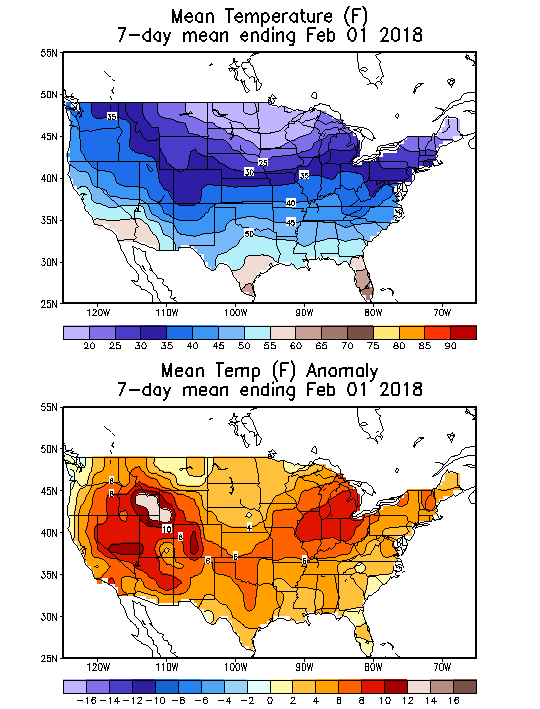
Source: NOAA National Weather Service
Deviation between average and normal (°F)
7-Day Mean ending Feb 01, 2018

Source: NOAA National Weather Service

